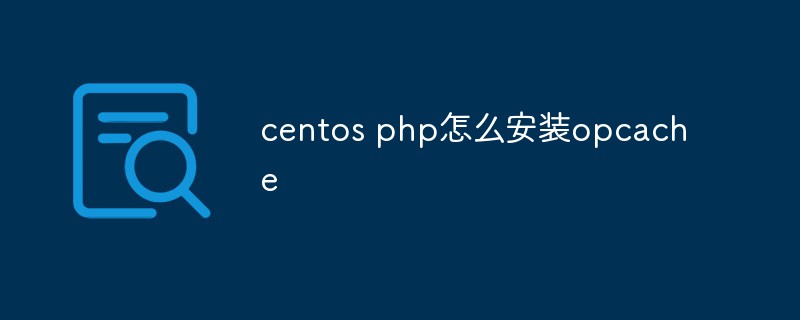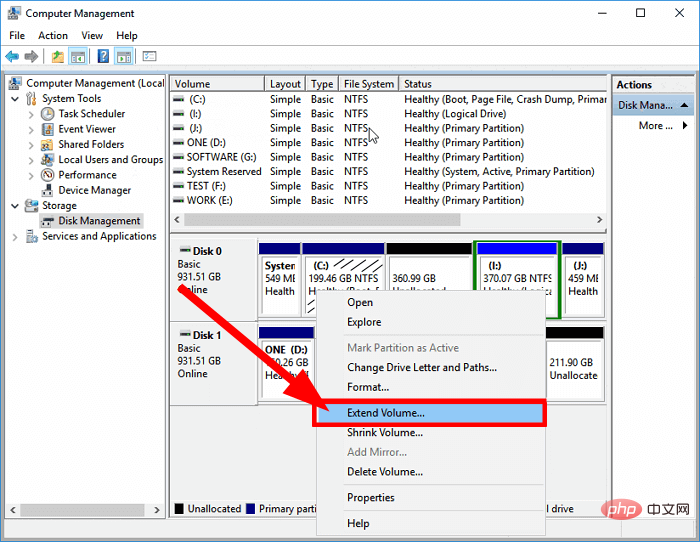How to install the php environment under centos: first install and start apache; then install mysql; then install php through the "yum install php php-devel" command; and finally restart apache.

Recommended: "centos Getting Started Tutorial"
1. Install apache:
yum install httpd httpd-devel
Start apache:
/bin/systemctl start httpd.service
At this time, enter the IP address of the server in the browser address bar. You should see the apache service page. There is no need to enter the port. Apache uses port 80 by default. If the port changes If you lose, you will lose.
You may not be able to access it. You need to turn off the
firewall in Centos 7:
systemctl stop firewalld.service #停止firewall systemctl disable firewalld.service #禁止firewall开机启动 firewall-cmd --state #查看默认防火墙状态(关闭后显示notrunning,开启后显示running)
2. Install mysql:
yum install mysql mysql-server
Start mysql:
systemctl start mysql.service
To This is the prompt when starting the MySQL database
Failed to start mysqld.service: Unit not found
The solution is as follows:
First you need to install mariadb-server
yum install -y mariadb-server
Start the service
systemctl start mariadb.service
Add to boot
systemctl enable mariadb.service
This is complete!
You can test it
mysql -u root -p
3. Install php
yum install php php-devel
Restart apache to make php take effect
/bin/systemctl start httpd.service
At this time, you can in the directory :Create a PHP file index.php under /var/www/html/, add the code:
<?php phpinfo(); ?>
Then access this file in the browser, you can see some information about PHP, the php.ini configuration file The path can be seen on this page
If you want to install the PHP7 version, please see the following operations
Install PHP7 through yum on centos7, first run it in the terminal:
rpm -Uvh htt[ps](http://www.111cn.net/fw/photo.html)://mirror.webtatic.com/yum/el7/webtatic-release.rpm
Prompt error :
error: Failed dependencies: epel-release >= 7 is needed by webtatic-release-7-3.noarch
Need to install epel-release first.
1. Install epel-release
Pass the command:
rpm -ivh http://dl.fedoraproject.org/pub/epel/epel-release-latest-7.noarch.rpm
Successfully installed.
2. Install PHP7
Run the following command again on the terminal:
rpm -Uvh https://mirror.webtatic.com/yum/el7/webtatic-release.rpm
Successfully obtain the yum source of PHP7, and then execute it again:
yum install php70w
You're done .
3. Verify installation
Terminal command: php -v, displays the current PHP version, the information is as follows:
[root@iZ94w0kemvtZ /]# php -v PHP 7.0.2 (cli) (built: Jan 9 2016 14:00:11) ( NTS ) Copyright (c) 1997-2015 The PHP Group Zend Engine v3.0.0, Copyright (c) 1998-2015 Zend Technologies
In this way, PHP7 is successfully installed through yum under CentOS 7.
Install php extension
yum install php-mysql php-gd php-imap php-ldap php-odbc php-pear php-xml php-xmlrpc
After installing the extension, you need to restart apache again
/bin/systemctl start httpd.service
The above is the detailed content of How to install php environment under centos. For more information, please follow other related articles on the PHP Chinese website!
 centos用什么命令可查版本号Mar 03, 2022 pm 06:10 PM
centos用什么命令可查版本号Mar 03, 2022 pm 06:10 PM查版本号的命令:1、“cat /etc/issue”或“cat /etc/redhat-release”,可输出centos版本号;2、“cat /proc/version”、“uname -a”或“uname -r”,可输出内核版本号。
 centos重启网卡的方法是什么Feb 22, 2023 pm 04:00 PM
centos重启网卡的方法是什么Feb 22, 2023 pm 04:00 PMcentos重启网卡的方法:1、对于centos6的网卡重启命令是“service network restart”;2、对于centos7的网卡重启命令是“systemctl restart network”。
 centos php怎么安装opcacheJan 19, 2023 am 09:50 AM
centos php怎么安装opcacheJan 19, 2023 am 09:50 AMcentos php安装opcache的方法:1、执行“yum list php73* | grep opcache”命令;2、通过“yum install php73-php-opcache.x86_64”安装opcache;3、使用“find / -name opcache.so”查找“opcache.so”的位置并将其移动到php的扩展目录即可。
 centos 怎么离线安装 mysqlFeb 15, 2023 am 09:56 AM
centos 怎么离线安装 mysqlFeb 15, 2023 am 09:56 AMcentos离线安装mysql的方法:1、将lib中的所有依赖上传到linux中,并用yum命令进行安装;2、解压MySQL并把文件复制到想要安装的目录;3、修改my.cnf配置文件;4、复制启动脚本到资源目录并修改启动脚本;5、将mysqld服务加入到系统服务里面;6、将mysql客户端配置到环境变量中,并使配置生效即可。
 centos 7安装不出现界面怎么办Jan 03, 2023 pm 05:33 PM
centos 7安装不出现界面怎么办Jan 03, 2023 pm 05:33 PMcentos7安装不出现界面的解决办法:1、选择“Install CentOS 7”,按“e”进入启动引导界面;2、 将“inst.stage2=hd:LABEL=CentOS\x207\x20x86_64”改为“linux dd”;3、重新进入“Install CentOS 7”,按“e”将“hd:”后的字符替换成“/dev/sdd4”,然后按“Ctrl+x”执行即可。
 centos 怎么删除 phpFeb 24, 2021 am 09:15 AM
centos 怎么删除 phpFeb 24, 2021 am 09:15 AMcentos删除php的方法:1、通过“#rpm -qa|grep php”命令查看全部php软件包;2、通过“rpm -e”命令卸载相应的依赖项;3、重新使用“php -v”命令查看版本信息即可。
 如何在 CentOS 9 Stream 上安装 NagiosMay 10, 2023 pm 07:58 PM
如何在 CentOS 9 Stream 上安装 NagiosMay 10, 2023 pm 07:58 PM我们的PC中有一个磁盘驱动器专门用于所有与Windows操作系统相关的安装。该驱动器通常是C驱动器。如果您还在PC的C盘上安装了最新的Windows11操作系统,那么所有系统更新(很可能是您安装的所有软件)都会将其所有文件存储在C盘中。因此,保持此驱动器没有垃圾文件并在C驱动器中拥有足够的存储空间变得非常重要,因为该驱动器拥有的空间越多,您的Windows11操作系统运行起来就越顺畅。但是您可以在磁盘驱动器上增加多少空间以及可以删除多少文件是有限制的。在这种情况下,
 centos中ls命令不显示颜色怎么办Apr 20, 2022 pm 03:16 PM
centos中ls命令不显示颜色怎么办Apr 20, 2022 pm 03:16 PM方法:1、利用“vim ~/.bashrc”编辑用户目录(~)下的“.bashrc”文件;2、在文件内添加“alias ls="ls --color"”;3、利用“:wq!”命令保存文件内的更改;4、“exit”命令退出终端后重新连接即可。


Hot AI Tools

Undresser.AI Undress
AI-powered app for creating realistic nude photos

AI Clothes Remover
Online AI tool for removing clothes from photos.

Undress AI Tool
Undress images for free

Clothoff.io
AI clothes remover

AI Hentai Generator
Generate AI Hentai for free.

Hot Article

Hot Tools

SublimeText3 Chinese version
Chinese version, very easy to use

SublimeText3 Mac version
God-level code editing software (SublimeText3)

MantisBT
Mantis is an easy-to-deploy web-based defect tracking tool designed to aid in product defect tracking. It requires PHP, MySQL and a web server. Check out our demo and hosting services.

Dreamweaver CS6
Visual web development tools

DVWA
Damn Vulnerable Web App (DVWA) is a PHP/MySQL web application that is very vulnerable. Its main goals are to be an aid for security professionals to test their skills and tools in a legal environment, to help web developers better understand the process of securing web applications, and to help teachers/students teach/learn in a classroom environment Web application security. The goal of DVWA is to practice some of the most common web vulnerabilities through a simple and straightforward interface, with varying degrees of difficulty. Please note that this software






